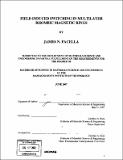Field induced switching in multilayer rhombic magnetic rings
Author(s)
Pacella, James N
DownloadFull printable version (3.586Mb)
Other Contributors
Massachusetts Institute of Technology. Dept. of Materials Science and Engineering.
Advisor
Caroline A. Ross.
Terms of use
Metadata
Show full item recordAbstract
Multilayer rhombic magnetic rings are researched as a structure for the "pseudo spin valve" device that could possibly become useful in magnetic materials applications such as MRAM, digital logic, and sensors through the use of multiple resistance states exhibited within these devices. The magnetization reversal characteristics of these structures are explored in an effort to fully understand interactions occurring within the devices and their resulting effect on giant magnetoresistance (GMR). Contact configuration and angular dependence of applied field are also examined. Using submicron thickness rhombic rings with long axis dimension -1.5gjm, major loop magnetization sweeps were conducted, as well as minor loops in order to excite several resistance states within the devices. It was found from major loop applied field sweeps that rhombic multilayer rings exhibit five stable magnetoresistive states, with an additional state excited through execution of a minor loop field sweep. In addition, using the contact configurations known as "classical" and "wheatstone bridge" provide additional information on interactions that are occurring within the structures. It was found that both contact configurations were sensitive to similar changes in the devices, however, through different means of sensing. The major difference results in a larger GMR output in the wheatstone bridge configuration (-20%) versus the classical configuration (-1%). Preliminary work in angular dependence has shown the ability to alter resistance plateaus by changing the angle of applied field. Ultimately shown through this work is the amount of research that is still needed to truly understand these devices, as they contain more complex stable and metastable states of magnetization than generations and shapes before them.
Description
Thesis (S.B.)--Massachusetts Institute of Technology, Dept. of Materials Science and Engineering, 2007. "June 2008." Includes bibliographical references (leaf 28).
Date issued
2007Department
Massachusetts Institute of Technology. Department of Materials Science and EngineeringPublisher
Massachusetts Institute of Technology
Keywords
Materials Science and Engineering.